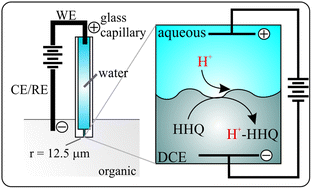Detection of Pseudomonas aeruginosa quorum sensing molecules at an electrified liquid|liquid micro-interface through facilitated proton transfer†
Abstract
Miniaturization of electrochemical detection methods for point-of-care-devices is ideal for their integration and use within healthcare environments. Simultaneously, the prolific pathogenic bacteria Pseudomonas aeruginosa poses a serious health risk to patients with compromised immune systems. Recognizing these two factors, a proof-of-concept electrochemical method employing a micro-interface between water and oil (w/o) held at the tip of a pulled borosilicate glass capillary is presented. This method targets small molecules produced by P. aeruginosa colonies as signalling factors that control colony growth in a pseudo-multicellular process known as quorum sensing (QS). The QS molecules of interest are 4-hydroxy-2-heptylquinoline (HHQ) and 2-heptyl-3,4-dihydroxyquinoline (PQS, Pseudomonas quinolone signal). Hydrophobic HHQ and PQS molecules, dissolved in the oil phase, were observed electrochemically to facilitate proton transfer across the w/o interface. This interfacial complexation can be exploited as a facile electrochemical detection method for P. aeruginosa and is advantageous as it does not depend on the redox activity of HHQ/PQS. Interestingly, the limit-of-linearity is reached as [H+] ≈ [ligand]. Density functional theory calculations were performed to determine the proton affinities and gas-phase basicities of HHQ/PQS, as well as elucidate the likely site of stepwise protonation within each molecule.



 Please wait while we load your content...
Please wait while we load your content...